|
|
|
|
|
|
|
Achi-Kochi Japan
Showing many places to visit and foods to eat in Japan
|
|
|
|
|
|
|
|
|
|
|
|
|
Japan
> Koh-Shin-Etsu region
> Matsumoto City
|
|
|
|
|
|
|
Matsumoto City
Nagano Pref., Koh-Shin-Etsu ( Achi-Kochi Japan )
|
|
|
|
|
|
|
|
|
|
|
|
|
( "Achi-Kochi" in Japanese means "Here and there" in English. )
Matsumoto City, Nagano Pref., Koh-Shin-Etsu region

Matsumoto City is the second largest city in Nagano Prefecture and is located in the center of Koh-Shin-Etsu region ( above ). The city is surrounded by mountains, a few of which are higher than 3,000m. Its population is almost 240 thousands.
|
|
Matsumoto-jo Castle
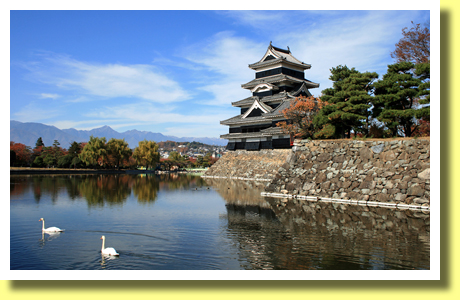
Matsumoto-jo ( above ), built in A.D.1594 or so, is the oldest among remaining castles and is one of the five castles designated as National Treasures of Japan. Above all, it is one of the most beautiful castles. The castle is too popular, especially in high season, it is possible for visitors to wait for two hours to enter.
|
|
Sengoku Jidai
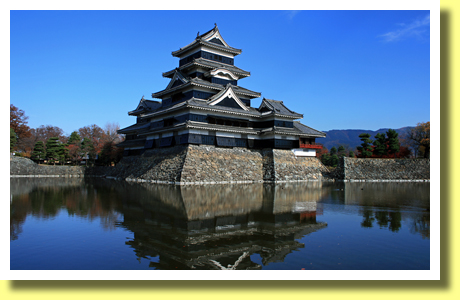
At the site of Matsumoto-jo castle ( above ), Fukashi-jo castle was built in A.D.1504 by the Ogasawara family, one of warring lords, who ruled the territory at the time. In A.D.1550 the territory was taken from the Ogasawara family by Shingen Takeda, a famous and powerful warring lord, who dominated the castle and the territory ( ==> A History of Japan vol.2 Samurai Age ).
In A.D.1582 the Takeda family was destroyed by Nobunaga Oda, the most powerful warring lord, to whom the castle and the territory belonged then. However, three month later Nobunaga Oda was killed by one of his own vassals. Sadayoshi Ogasawara, one of the Ogasawara family, took advantage of the confusion, recovered the Fukashi-jo castle. It is said that he renamed the territory "Matsumoto".
However, in A.D.1590, Sadayoshi Ogasawara was ordered to move and Hideyoshi Toyotomi gave the Fukashi-jo castle and Matsumoto to the Ishikawa family, a new feudal lord of Matsumoto Domain. The Ishikawa family started the construction of Matsumoto-jo castle in the site of Fukashi-jo castle.
In A.D.1613, the Ishikawa family lost the Matsumoto Domain, which was given to the Ogasawara family by Ieyasu Tokugawa, who had established Tokugawa Shogunate in Edo ( Tokyo now ) in A.D.1603. It is said that Sengoku Jidai ( the Age of Warring States ) was over at the end of the 16th century.
|
|
Inside Castle
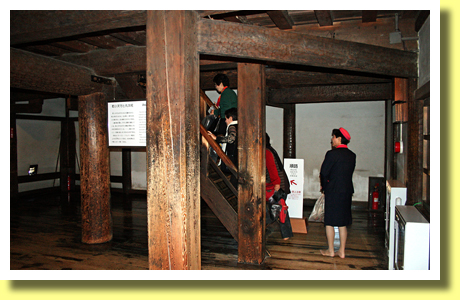
It is not easy to walk up stairs in Matsumoto-jo, six-story castle, in which stairs ( above ) are so narrow and steep. In Sengoku Jidai when the castle was built, it should not be easy for intruders to walk up stairs. Also ceilings are low. It should be difficult for intruders to use weapons such as swords and spears in the castle.
|
|
Weapons

Inside the castle, visitors could see armours, swords, spears and matchlock guns ( above ) which were used in Sengoku Jidai. Matchlocks were introduced in Japan in A.D.1543 by Portuguese. It is said that Nobunaga Oda made his forces use thousands of matchlocks in the battle in A.D.1575. Matsumoto-jo castle has lots of narrow windows to be used by gunmen and archers.
|
|
View
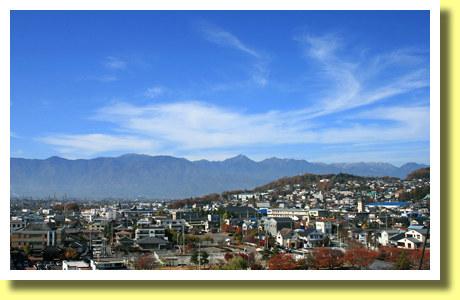
The top floor of Matsumoto-jo castle offers fine views ( above ) of mountains of Japanese Alps and Mstsumoto city as well as moats surrounding the castle.
|
|
Former Kaichi School
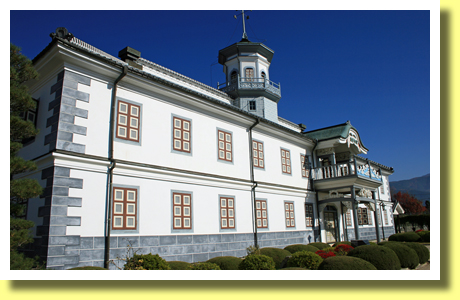
The former Kaichi Gakko, located within a few minutes walk from Matsumoto-jo castle, is a school built in Matsumoto in A.D.1876 as one of the first schools in Japan and now one of designated National Treasures of Japan.
The school looks built in European style, while some elements of Japanese architecture can be found. The master carpenter, experienced in Japanese style construction, looked round the European style buildings in Tokyo and Yokohama. Then he started the construction. So the hybrid style structure was completed.
|
|
Inside Former Kaichi School

Inside the former Kaichi School, there is a classroom ( above ) preserved as it was in the 19th century. Visitors could sit in the small wooden desks as children did 150 years ago.
During Tokugawa Period, it was only the children of samurai people who were provided with the opportunities of higher education , while some children of farmers, shopkeepers and craftsmen learned just in elementary schools run by temples and so on.
In A.D.1868, Tokugawa Shogunate was overthrown and in A.D.1872, Meiji Government reformed the national education system. Then common people in Matsumoto, hoping their children educated well, donated more than two thirds of the cost of building a school. So the construction started in A.D.1873 and the former Kaichi School was completed in A.D.1876.
|
|
Textbooks

Inseide the former Kaichi School, visitors would see lots of textbooks used by the children in the 19th-20th century. The above shows a textbook regarding Shinano ( now Nagano Prefecture ), which was issued in A.D.1880.
|
|
Former Priest's House
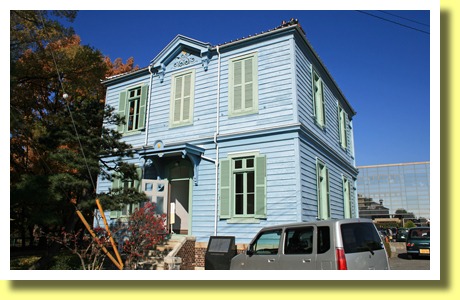
Near the former Kaichi School, there is the former priest's house, built in A.D.1889 by a French Father. Visitors could walk inside the building. In the 17th century, Tokugawa Shogunate prohibited Japanese people to believe in Christianity and no Christian priest to land on Japan. It was in the 19th century that the Meiji Government lifted the ban on Christianity.
|
|
Nakamachi Street
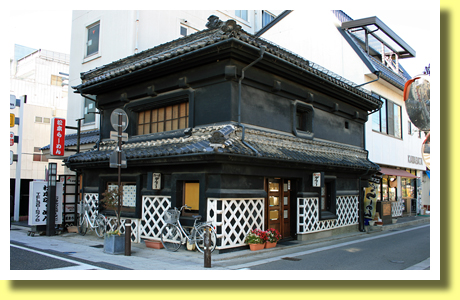
In Matsumoto city, it could be fun to walk along Nakamachi Street, which used to be a merchant district. There remain some Kura ( old traditional warehouses ) built a few centuries ago. Kura buildings ( above ) have black-and-white and criss-cross patterned walls.
Also Nakamichi Street is a famous shopping area where tourists could buy traditional Japanese handicfafts such as lacquerware, pottery, wooden puroducts and so on. Also there are many restaurans, some of which offer soba ( buckwheat noodles ), for which Nagano Prefecture is famous.
|
Copyright (c) 2021 Achi-Kochi Zanmai Co., Ltd.
|